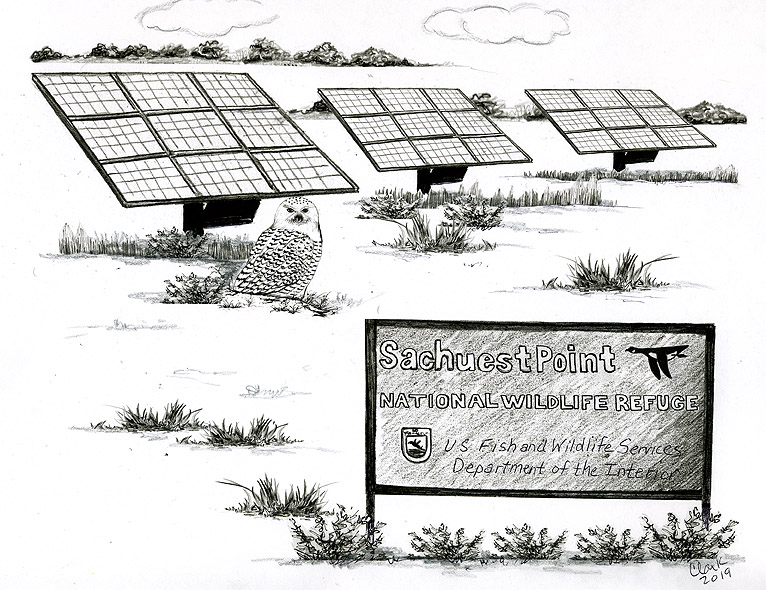
Visiting Sachuest Point National Wildlife Refuge:
Even though it’s early spring, many of the Cape’s best birding spots are still pretty quiet. I had been trying to think of an off-Cape birding area to explore, when I overheard customers chatting about Rhode Island’s Sachuest Point National Wildlife Refuge. Bingo! Why didn’t I think of that? I felt like whacking myself on the head and yelling, “I shoulda had a V8,” but I didn’t. Sachuest Point is one of those birding areas that often have better birds during the colder months. Plus, it’s only a tank of gas away…or in my case, a single electric charge away. I punched up the GPS, plugged in my car, told my wife to grab her binoculars, and to dress warm. It can be cold there.
Sachuest Point is in the municipality of Middletown, which is located in an oddly segregated section of Rhode Island that’s actually closer to Fall River, MA than to the rest of RI. For most of the last century, Sachuest Point (pronounced “sa-shoe-est,” and not “sa-chew-est,” as I’ve been saying) was a Naval communication center. In the 1970s, with the help of land donated by RI Audubon, the area was transformed into a wildlife refuge. Only 242 acres, the refuge has several easy hiking trails, plenty of parking, a newly renovated visitor center and is free. Sweet! And to make things even better, Sachuest is only five miles from Newport and lots of good places for lunch. I know one spot that even serves quinoa and avocado burgers. Yum! Right? Before hiking Sachuest Point, it’s good to take a deep breath and simply appreciate the amazing views. To the east is the historic Sakonnet Point Lighthouse. To the south is the big, bad Atlantic Ocean and to the west, sitting on a distant hill, are the stately spires of St. George Episcopal Church. Most Cape Cod beaches consist of soft sand; this is the not the case at Sachuest Point. The entire peninsula is surrounded by rocks and crashing waves, which are why the birds, mostly sea ducks, are here.
On this particular day (late March) it was cold, but sunny. A harrier was hunting over a nearby field, flying just above the heads of three white-tailed deer. The bright sun must have stirred something inside the Song Sparrows because they were singing from every tree and shrub. The cardinals and mockingbirds were also active and noisy, but the sound that caught my attention was coming from the ocean. It sounded like a dog whining to go outside. I had never heard it before and was convinced it wasn’t coming from a bird. I was wrong. Just offshore, in the choppy surf, was a flock of at least 200 Black Scoters and the males were all whining away. (It must be a breeding thing.) I began to point the scoters out to my wife, but she was gone. She opted to spend her time climbing along the rocks, looking for sea glass. Sea glass? Really? (It must be a retired lady thing.)
While my wife picked her way along the beach, I focused on the ducks, and there were lots of them. In addition to the scoters, there were Buffleheads, Common Eiders, Horned Grebes and several Brant. But the birds most visitors go there to see are the Harlequin Ducks. With the exception of perhaps King Eiders, Harlequin Ducks are our most colorful sea ducks. But while King Eiders look like royalty, the slate blue, chestnut and white-striped harlequins look more like rodeo clowns, and are certainly more entertaining than broken glass.
As I climbed over the rocks to get a better look at the harlequins, I could see two women standing on a hill near the visitor center. It was an odd place to stand, but before I could give it much thought, an Orange-crowned Warbler popped up in front of me. I spent the next twenty minutes chasing the warbler, trying to snap its photo. (I never got it. This bird had far more energy than I had.) After giving up on the warbler, I noticed the two women were still standing in the same spot. Hmm. I decided they must be on to something and I should check it out. It was a good decision.
Just to the right of the visitor center is a small field containing three rows of solar panels. Roosting underneath one of the panels was a big, fluffy Snowy Owl. Nice find, ladies. Sachuest Point is one of the more reliable places to see these white Arctic birds, but if it weren’t for the two women, I would have walked right past it. According to the visitor center’s friendly volunteer, Barry, this owl often spends its days on the center’s roof, but not today. The 39° temperature was too warm for the snowy. It opted to snooze in the cooler shade of the solar panels. (Once again, green energy helps to fight the effects of global warming.)
As I chatted with the owl ladies, a small bird streaked overhead. It was a Tree Swallow, the first one I had seen since they had migrated last fall. I greeted the bird with a friendly wave and yelled, “Welcome back!” The women just stared at me. (I guess the tradition of welcoming birds back hasn’t found its way to Rhode Island…yet.) It was at this moment I received a text message from my wife. Oh, right. I had forgotten about her. She was still on the beach and still looking for glass, but she was also getting hungry. It was time to leave Sachuest Point and head into the bustling town of Newport. My wife didn’t know it at the time, but I had a wonderful treat in store for her. Well, it will be a treat if she likes quinoa and avocado burgers. Oh, of course, she does. Doesn’t everybody?